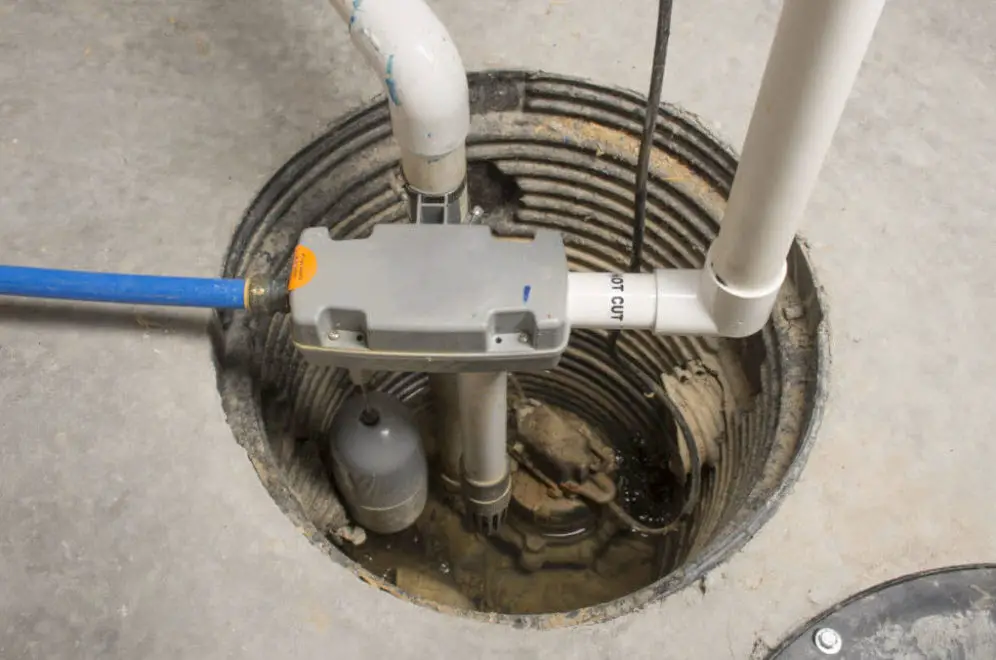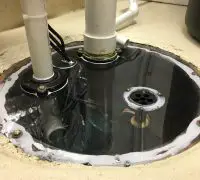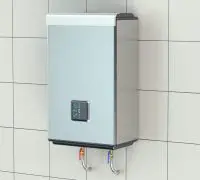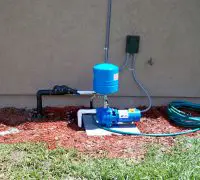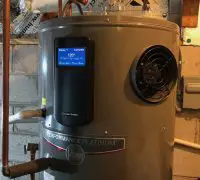Sump pumps are crucial in many households, as they keep the basement dry in case of heavy rains and prevent waterfloods. However, even the best sump pumps can develop problems in time and repairs will be necessary.
Sump pump issues
If you use a sump pump in your home, you probably know that proper maintenance is necessary to keep it up and running. Even so, the risk of sump pump problems is never null. Some of these problems could be minors, whereas others will require professional help for fixing.
Either way, you want to avoid sump pump failure, so pay attention to how your pump works. From the subtle humming noise to the foul smell or your sump pump working continuously, many signs inform you that something’s wrong.
Page Table of Contents
- Sump pump issues
- Do sump pumps fail?
- Has your sump pump quit working?
- 1. Sump pump check valve location
- 2. Is the sump pump alarm going off?
- 3. Is your sump pump beeping?
- 4. Sump pump is constantly running. What do you do?
- 5. What can you do if the sump pump has frozen?
- 6. How to fix a sump pump gurgling
- 7. Is your sump pump going off in winter?
- 8. Is your sump pump humming? Can you fix it?
- 9. Sump pump tripping GFCI. What’s the fix?
- 10. The sump pump keeps filling with water
- 11. The sump pump keeps cycling
- 12. The sump pump is loud
- 13. Sump pump loud bang? Here’s what do to about it!
- 14. Sump pump making noise after rain
- 15. Sump pump not draining. Here’s why!
- 16. Sump pump not turning on?
- 17. Sump pump not pumping—is it a severe problem?
- 18. Sump pump not turning off?
- 19. The float switch is stuck in the ON position
- 20. Sump pump overflows
- 21. Sump pump is overheating
- 22. Sump pump odor—what’s normal and what’s not?
- 23. The sump pump runs every 30 seconds – should you worry or not?
- Find a sump pump service near you
Do sump pumps fail?
A functional sump pump will save your house from water damage in a torrential downpour. It goes without saying that you don’t want your sump pump to fail, especially if it’s rainy season.
What happens when the sump pump fails?
If your sump pump fails, the excess water from a severe downpour will start to collect at the lowest point in your house—the basement, a crawlspace, or the foundation. Regardless of where it will settle, the water will make the wood warp, rot, and eventually cause mold growth.
Sometimes, the sump pump fails because you lose power in your home. You should always give a secondary generator, a backup battery, and even a backup sump pump. Should you live in an area with heavy rains, it’s wise to have a second sump pump.
How do you know that the sump pump is about to fail?
Even if we cannot predict everything, some signs will tell you that the sump pump isn’t far from failing:
Age
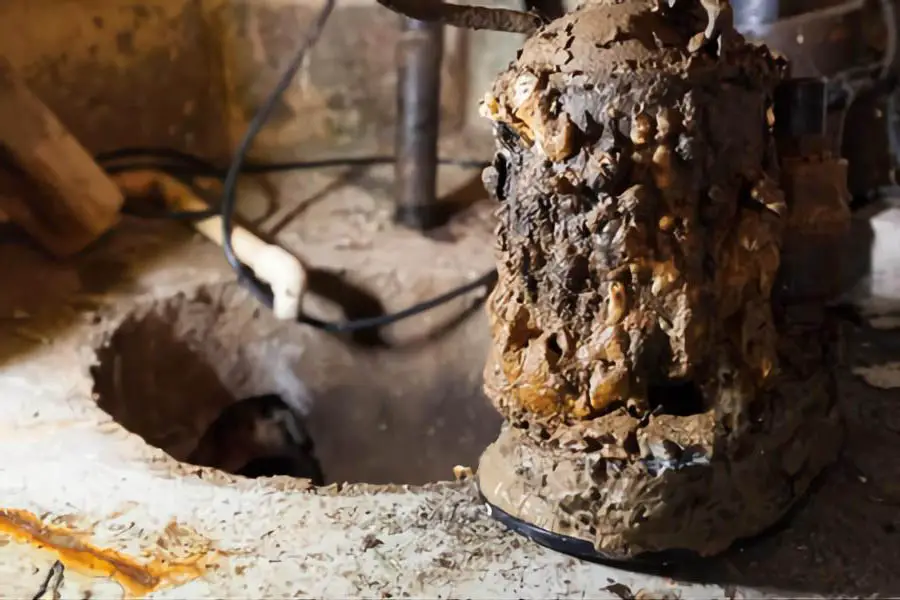 Most sump pumps are made to last for a decade, so you should expect yours to fail if it’s almost ten years old. We recommend you replace an old sump pump so that you don’t have surprises next time it rains.
Most sump pumps are made to last for a decade, so you should expect yours to fail if it’s almost ten years old. We recommend you replace an old sump pump so that you don’t have surprises next time it rains.
Clogged pump
Jammed float switches, tangled switches, and dirty mechanical parts can cause a clog in the sump pump, rending its failure.
Lack of water
If the sump pit has no water, even if the pump is running, your system wasn’t correctly connected to the drainage system or wasn’t installed properly.
Power loss
The sump pump can lose power for many reasons, such as a worn-out backup battery, severe basement flooding, or a blown a fuse.
What do you do?
The chances are that the sump pump will fail during a rainstorm. Here’s what you can do if the sump pump fails:
Extract water
Use a water pump or a wet vacuum to remove as much standing water as possible.
Restore water damage
Most of the time, you won’t be able to remove all of the standing water. We recommend you call a local water damage restoration company. They will use commercial-grade restoration equipment to restore the water damage.
Replace/repair
You want your sump pump to function back to normal. See if you can repair it or if you have to replace it altogether.
Has your sump pump quit working?
If your sump pump stopped working, you will need to start with the basic and check out the power source. However, such an issue can have several causes, so keep reading for the fixes:
Check out the power source
A power outage is the most common cause for a sump pump to stop working. The first step is to see if the pump gets any power. See if the cord is connected to the outlet and examine the circuits and fuses. Even if you have electricity in the house, it doesn’t mean that electrical issues cannot make your pump fail.
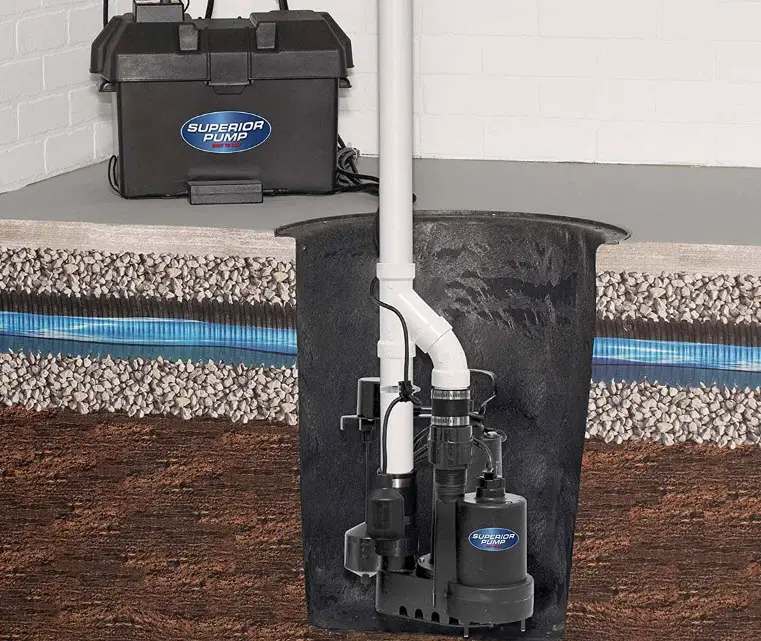 You should have a backup battery sump pump system to prevent pump power failures. If you already have one and the pump still doesn’t get power, you will also have to inspect the backup system’s water level. If necessary, add distilled water. Still not working? Your batteries might need replacement.
You should have a backup battery sump pump system to prevent pump power failures. If you already have one and the pump still doesn’t get power, you will also have to inspect the backup system’s water level. If necessary, add distilled water. Still not working? Your batteries might need replacement.
See if there are leaks in the discharge pipe
It’s easy to see the sump pump discharge pipe and spot any leaks. Go where the line exits your house’s foundation and search for signs of water outside. If the discharge pipe has leaks, the water will back up into the basement.
Look for debris in the sump pit
Jams and clogs can make the sump pump stop working. You have to open to pump lid and see if there’s debris in the pit. If so, try to remove as much as possible.
You might discover unusual things such as garden tools, children’s toys, etc.
Examine the impeller
The sump pump features a small filter (the impeller). A clogged impeller can make the sump pump not work anymore. You should clean or replace the impeller so that the sump pump starts operating again.
See if the float is malfunctioning
A malfunctioning or a worn-out float is another common cause of the sump pump not working anymore. You can fill the sump pit with water to start the sump pump again. If nothing happens, you might need to replace the float.
Clear the weep hole
Some sump pumps come with a weep hole, which can get clogged in time. You will find the weep hole between the pump and the check valve. Clear the hole with a narrow object like a toothpick so that you don’t break something into the hole.
Can the sump pump check valve malfunction?
The sump pump check valve (flapper style) is a one-way valve in the pump’s discharge pipe. When the pump starts operating, the force of the water will make the flapper open. Similarly, once the pump shuts off, the valve flapper will close as the gravity force will push it down. Valves with a flat seat make a clunking noise produced by a water hammer as the flapper closes entirely. The water hammer is the impact of the valve hitting the seat.
1. Sump pump check valve location
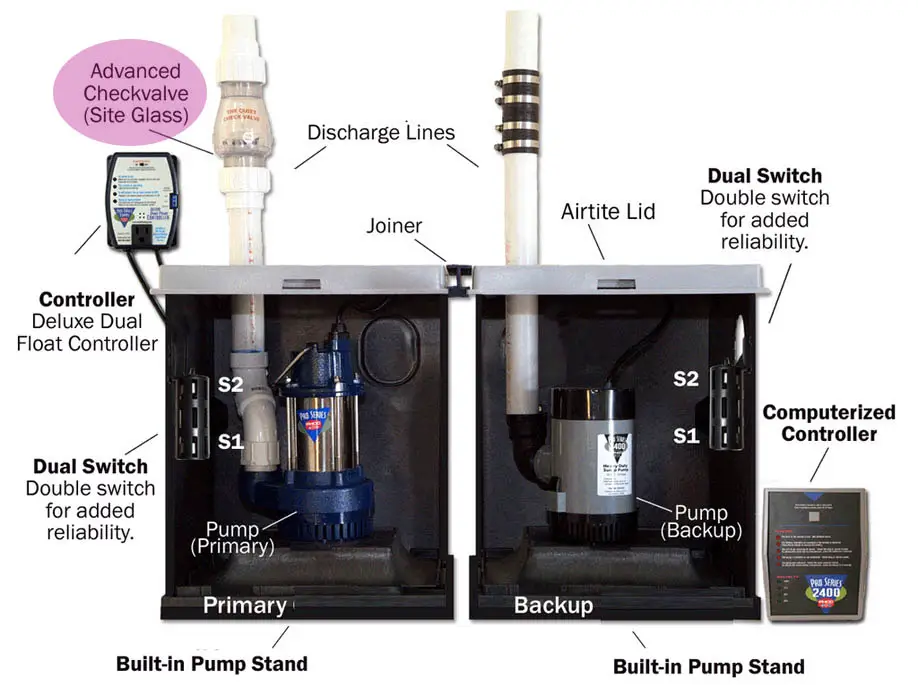 The benefits of installing a sump pump check valve are as follows:
The benefits of installing a sump pump check valve are as follows:
Check valves increase pumping efficiency
When the pump starts running, it will push the water through the valve. If the pump shuts off, gravity will make the water in the discharge pipe go right into the pit. The check valve will prevent that from happening. It will stop the pump from re-pumping the water out, which can cause short cycling. You will save on electricity if the short cycling is gone.
Check valves protect the sump pump
Short cycling makes the pump motor get hot, which can shorten the lifespan of your sump pump. With a check valve, you decrease the risk of short cycling and help the sump pump last longer.
What’s the proper sump pump check valve location?
A good location for the check valve is close to the floor level to reduce the volume of water draining back at the end of a pumping cycle. This location also eases out servicing and replacement of the valve. Servicing and replacement will be complex if you install the check valve inside the sump pit.
What happens if you don’t use a check valve? It may poorly installed
If you don’t install a sump pump check valve, the water in the discharge pipe will empty back into the sump pump pit. The water level will rise and the pump will start running more frequently.
Poor installation of the check valve (too high up on the discharge pipe, for instance) will make the pump empty the pit during the run cycle. However, when it shuts off, the water below the check valve will go back into the basin so that the water level will increase quickly. If so, the float switch will make the pump run immediately, shortening the lifespan of your sump pump.
2. Is the sump pump alarm going off?
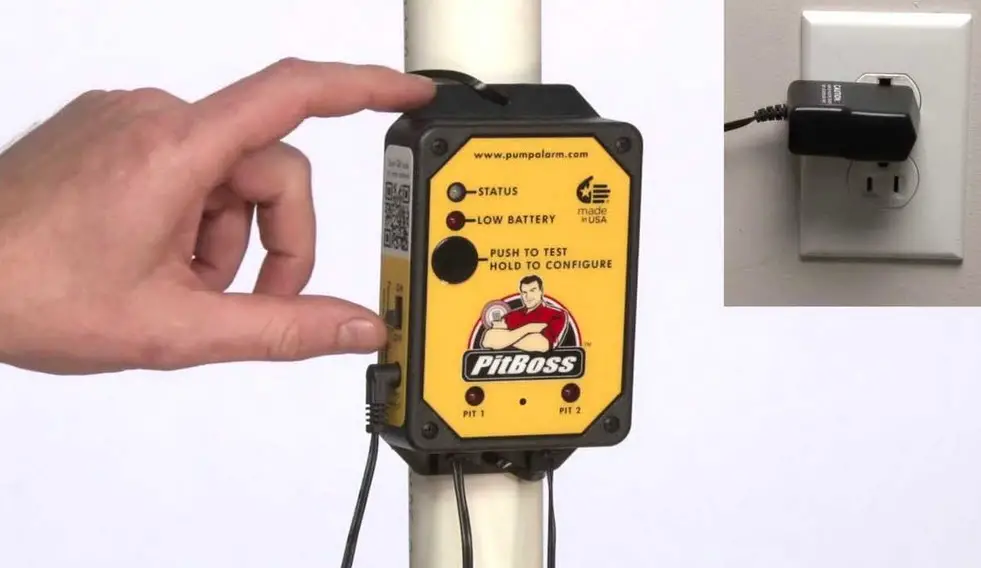 Typically, the sump pump alarm will go off when the water in the sump container increases to 6″ below the lid. Most of the time, your sump pump might not work for two reasons:
Typically, the sump pump alarm will go off when the water in the sump container increases to 6″ below the lid. Most of the time, your sump pump might not work for two reasons:
- It doesn’t get any or not enough power
- The pump is worn out, old, and needs replacement
However, there are some other causes for the alarm going off.
It senses water
Even though it’s rare, the sump pump alarm can also go off when it senses water. If so, a plumbing leak may have triggered the alarm.
Extreme weather
An extreme weather event can increase the amount of water and the sump pump cannot work correctly and efficiently.
What can you do?
Start by checking out the power source. Nine times out of ten, the alarm goes off because the pump doesn’t get any power. The pump is plugged right into the outlet without an extension cord. Also, check if the outlet has power by unplugging the pump and plugging in another small appliance.
If the outlet doesn’t get any power, you must re-set the breaker. Call an electrician if the outlet doesn’t get power. Use an extension cord to power the sump pump until the dedicated outlet is fixed.
If the breaker stops running only when you plug in the pump and not when you use other appliances, the pump is jammed or failing. We also recommend you verify the discharge line and pop-up drain. The pump will stop working and sound the alarm if they’re covered with debris.
All things considered, the alarm will sound every time it senses water. If the alarm sensor is underwater, you will have to wait around 72 hours until it dries out completely. If 72 hours go by and the alarm still goes off, the alarm will need to be dried out, fixed, and even replaced.
3. Is your sump pump beeping?
If your sump pump keeps beeping, the alarm may be the cause, or the system only informs you that the pump will start operating. When you hear unexpected beeping sounds from the crawl space or basement, you should check it out and see that there’s no flooding. Make sure that the sump pump alarm sounds only in case of flooding.
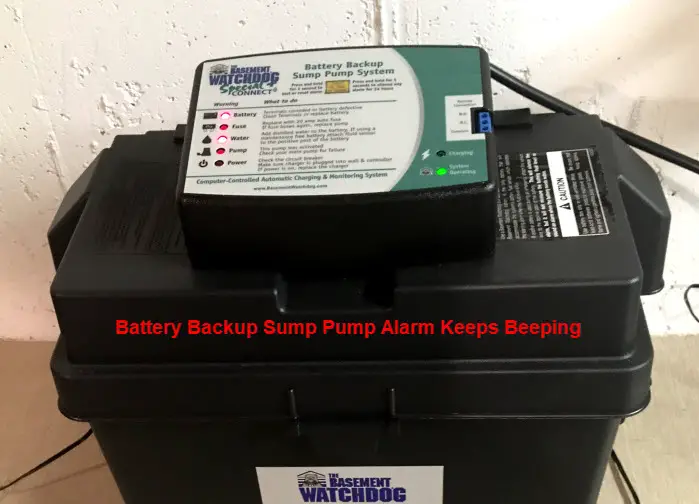 Sometimes, the beeping can simply inform that the batteries in the alarm are low and you need to replace them. Most sump pumps come with high-quality alarms and alerts. Every time you hear a beeping sound, you should check it out. Most pump alarms will beep if they detect an issue. High-end models will send text message alerts to your phone in case of a power outage and flooding.
Sometimes, the beeping can simply inform that the batteries in the alarm are low and you need to replace them. Most sump pumps come with high-quality alarms and alerts. Every time you hear a beeping sound, you should check it out. Most pump alarms will beep if they detect an issue. High-end models will send text message alerts to your phone in case of a power outage and flooding.
The sump pump battery may beep for several reasons:
Low battery fluid
The sump pump alarm can beep when the battery is low on fluid. Examine the battery from time to time to ensure it’s in good condition.
Bat battery
The battery might be low on power or bad. Check out the battery now and then to ensure it’s in good condition.
Loose power cables
The sump pump could also beep because the cables are loose. The beeping sound informs you to check out the cables and replace/tighten the loose cables.
Power issue
Sometimes, the beeping sound might not come from the sump pump. A failing fuse or power outlet could make the pump beep.
4. Sump pump is constantly running. What do you do?
Unless there’s a heavy rainstorm, you don’t want your sump pump running continuously. Apart from the high electricity bill, a sump pump will overheat and die long before its time. If the sump pump keeps running, several issues may cause it:
Float switch malfunction
The float switch will know/sense when the sump pump needs to start running. The float stays at the water’s surface and rises when the pit fills with water. If the float gets to a set point, it will trigger the float switch to the pumping phase. Water will be pulled into the pump and pushed up the discharge pipe until it’s drained into the drain system or released outside.
If the sump pump keeps running, you must see if the float and arm aren’t tangled/stuck in the pump’s electrical cord. Should the float move smoothly without obstruction, the float switch might be the issue. Buy replacement and get the correct float switch. Sometimes, it will be cheaper and wiser to replace the whole sump pump than repair and replace the float switch.
A faulty check valve
A faulty check valve could make your sump pump run constantly. You can find the check valve on the discharge pipe, right above the sump pump. If this valve isn’t properly functioning, the water will go up and down the line, causing the continuous operation of your sump pump.
Start by verifying if a check valve is installed. It’s pretty often for homeowners to skip installing a check valve. Even the best check valves will wear out and eventually fail if not replaced. Removing and replacing an old check valve isn’t tricky as ring clamps typically keep it in place.
The discharge pipe is clogged
When you’ve checked everything and the sump pump still doesn’t stop running, you must examine the discharge pipe. Sediment can collect and the line can get blocked when it discharges outside. As a result, the water will remain in the sump pump system. Use a wire hanger or a drain snake into the discharge pipe to loosen up blockages. Don’t pour a drain cleaner product into the pit of the sump pump.
5. What can you do if the sump pump has frozen?
One way to avoid sump pump line freezing is to keep your basement/crawl space warm. Keeping the basement warm can be challenging if you live in a cold climate, so you should at least keep it warm enough so that the systems, including the sump pump, operate efficiently. However, if you have to deal with a sump pump line frozen, you will need to take the following steps:
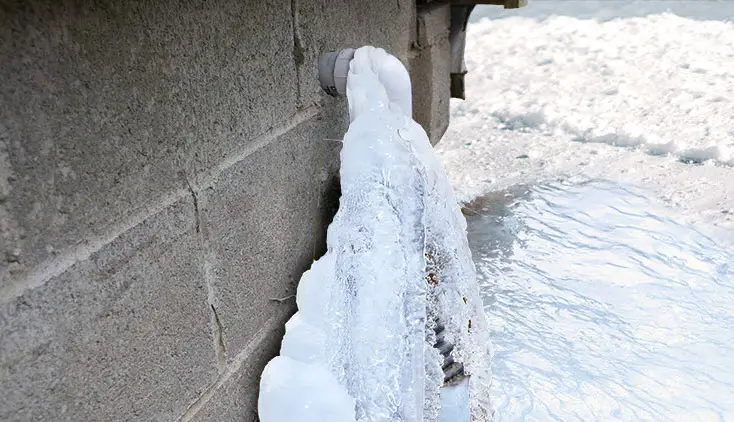 Cut the power
Cut the power
Every time you plan to work around water, you need to begin with turning off the power. You can flip the switch on the breaker or completely unplug the sump pump (alarm). You want to reduce the risk of injuries as much as possible.
Remove standing water
Should you see standing water in the pump/bin, you need to remove it through the drain or with a pump. To unfreeze the sump pump line, you will have to increase the temperature and eliminate the standing water.
Increase the temperature
Increase the temperature in the basement by turning on the heater/or installing a space heater near the pump. If the sump pump or lines are frozen, they won’t be able to drain the pit and keep the basement dry.
Increasing the temperature above freezing is the most effective way to unfreeze the sump pump and even prevent its freezing. You don’t need to be a professional contractor to know that basements are typically the coldest areas of the house, especially if the windows don’t have proper insulation.
See if there are any blocks
Ice, snow, and debris can clog the pump pipes and cause freezing. You want the line to flow, so remove as much as possible.
Pour boiling water
Boil a large pot of water and slowly pour the hot water down the frozen pump pipes.
The most obvious thing to do is defrost the pump, unfreeze the lines, and raise the temperature in your basement, but that might not be an option if it is the middle of winter. Plus, you don’t want to damage the pump while warming it up.
What do you do with frozen sump pump hoses?
Sometimes, it’s not the sump pump that has frozen but the hoses. With a sump pump hose frozen, you can have as many issues as with broken pumps. When the temperatures drop below freezing, you should check out the sump pump hoses. If they have frozen, you can use some towels from the dryer to warm them up. Use a blanket to wrap and cover the hoses.
6. How to fix a sump pump gurgling
The gurgling noise is quite common out of the many sounds a sump pump can make. Typically, water flowing back down the discharge pipe after the pump cycles will generate gurgling noise.
Here’s what you can do to fix it:
Replace the check valve
As mentioned, many sump pumps use a check valve near the discharge pipe so that the water flows in one direction while the sump pump is operating. If you hear a gurgling sound, the flap may not close correctly or be strong enough to close quickly, making water and air escape. You hear water gurgling at the valve.
We recommend removing the flapper-style check valve and installing a spring-loaded model instead. The spring-loaded action is more decisive than the classical flapper. It will close smoothly when the sump pump stops and remains closed, so the water doesn’t get back down the discharge pipe.
Add a weep hole
The sump pumps can get ” air locked ” as the air flows back into the pump chamber; the sump pumps can get “air locked.” Airlocks can stop the sump pump from pushing water through the pump and the discharge line. This can dry the pump motor, overheat, and even burn out.
You can drill a weep hole to push the trapped air outside the pump. Use a power drill to make a 3/16 hole between the check valve and the discharge pipe. Seek that the hole is drilled at a 45-degree angle below the waterline. If your sump pump already has a weep hole, check it out to see if debris isn’t clogging it.
Adjust the pump switch height
Sump pumps are supposed to stop operating before the pit runs dry. If not, the pumps will suck air with the remaining water, which causes the gurgling sounds. You may adjust the pump switch height to stop the sump pump from running dry. Examine the pump switch mechanism; it shouldn’t have any corrosion or rust.
Add a fitted basin cover
You can reduce the gurgling noises but not necessarily eliminate them. If the sump pump basin is open, it will amplify the gurgling sounds and make them echo in the whole house.
You may add a fitted or insulated basin cover to dampen the noise and reduce vibration. Many new sump pump kits come with insulated covers, but you can also make one of thick foam insulation.
Remove debris from the discharge pipe
If there’s a restriction in the water flow through the discharge pipe, it will travel back down the line and check the valve. In time, gunk and debris will collect inside the line, slow down and even block water flow within the pipe.
Start by disconnecting the discharge pipe from the sump pump. Use a metal hanger wire or a plumber’s snake to clean the pipe. Remove all left debris inside the line with a high-pressure hose.
7. Is your sump pump going off in winter?
We need to inform you that sump pumps will run from time to time in the winter due to melted snow collected in the sump pit. However, if the sump pump keeps running in winter, you deal with a problem.
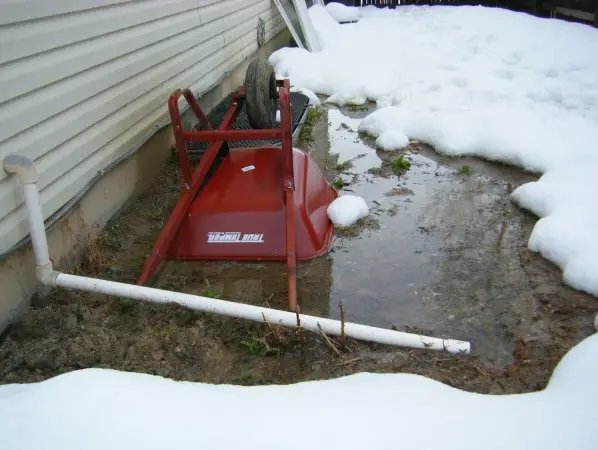 The most common cause of the sump pump running in the winter is not removing the flex hose. The hose connects to the pump’s plastic drain piping along the exterior of your house and should take water away from your house’s foundation. When you don’t remove the flex hose before winter, the hose will freeze and alter the sump pump operation. When the sump pump has to operate to remove moisture in the pit, the frozen flex hose will block the moisture. As a result, you will deal with a sump pump running in winter without stopping.
The most common cause of the sump pump running in the winter is not removing the flex hose. The hose connects to the pump’s plastic drain piping along the exterior of your house and should take water away from your house’s foundation. When you don’t remove the flex hose before winter, the hose will freeze and alter the sump pump operation. When the sump pump has to operate to remove moisture in the pit, the frozen flex hose will block the moisture. As a result, you will deal with a sump pump running in winter without stopping.
If the sump pump runs for a long time without removing the moisture from the sump pit may overheat and even burn out. When you prepare your house for the winter, detach the flex hose. Needless to say, you have to re-attach it every spring so that the sump pump runs appropriately.
8. Is your sump pump humming? Can you fix it?
Even if your sump pump just hums and doesn’t wake you up in the middle of the night, you need to see what’s causing the annoying sound. Often, an airlock is the main reason the sump pump buzzes from time to time. The airlock occurs when the sump dries out frequently and exposes the base. If your sump pump has a vent hole, you clear it and turn the sump pump several times through the float switch. If the sump pump keeps humming, a sump pump jammed might cause it.
Here’s what you should do if the sump pump is humming:
Verify the valve
If the check valve is poorly installed or if the valve sticks in the closed position, the sump pump may cause the humming noise. Most check valves have arrows that show the water flow. The arrow points upward at “discharge” and not “pump.”
Take a look at the impeller
A jammed impeller can also cause a humming noise. Typically, debris clogs the impeller, which jams and makes the humming sound. You have to remove the impeller, clean its interior, and look at its parts. The blades shouldn’t be broken.
To prevent such issues, you can install a filter in the sump pump to gather debris.
Examine the discharge pipes
When the temperature goes below freezing and the sump pump humming doesn’t stop, a frozen discharge pipe could be the reason. If it’s winter, you can melt the ice with an infrared heater. Otherwise, you need to check out other types of blockages in the pipe. If there are too many elbows at 90 degrees, the water flow could be restricted. Typically, if there are more than three 90-degree elbows, the flow will reduce significantly. To help the water flow smoothly, we recommend having 45-degree elbows instead.
9. Sump pump tripping GFCI. What’s the fix?
If the sump pump keeps tripping GFCI, the causes are multiple. A ground fault or blockage from debris are common reasons. We recommend calling the professionals if the sump pump trips the circuit breaker.
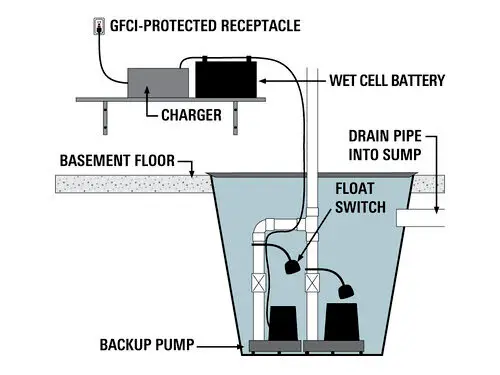
Water seeps into electrical connections
Water is damaging electrical equipment and connections. Even if the sump pump is sealed and designed to work with water, the connections, seals, and housing can become unsealed and loose after some time. As a result, moisture seeps in and can make the sump pump trip the breaker.
The sump pump doesn’t have a dedicated power outlet
The sump pump should have a dedicated outlet to plug into. The risk of using too much power is high when other devices are also plugged into the outlet. Also, the sump pump may not cause the issue, but another device connected to the same outlet.
It’s wise to use only a GFCI outlet for your sump pump. If the house is old and you don’t have a GFCI outlet, you will need to rewire the outlet for safety reasons. It’s also recommended that the sump pump, similar to the other appliances in your home, have a dedicated circuit.
There is no surge protection
The risk for a power surge is never null and you can prevent its damage to your system with a surge protector. We recommend installing surge protectors on every outlet to avoid power surge damage to your electronics.
The sump pump is old
If the sump pump trips the breaker very often, the sump pump could be old and might need replacement. Cheap pumps can be difficult to repair, whereas old models might be too expensive to fix. Look for a new pump that is made to work for many years and needs essential maintenance, such as lubricating the motor and lines.
A faulty wiring
If the wiring in the house is old, it might be trip breakers. If that’s the case for your household, we recommend you hire a licensed electrician to do some wiring. Since it’s not easy to understand the age of your wiring, we recommend you hire professionals for such tasks.
10. The sump pump keeps filling with water
Sometimes, the sump pump pit has a limited size or capacity, so the sump pump keeps filling with water. However, some other problems can cause the filling: high groundwater levels, a check valve missing, a stuck pump switch, and a clogged valve or drain. You will need to manually turn the switch, upgrade it, or replace the valve.
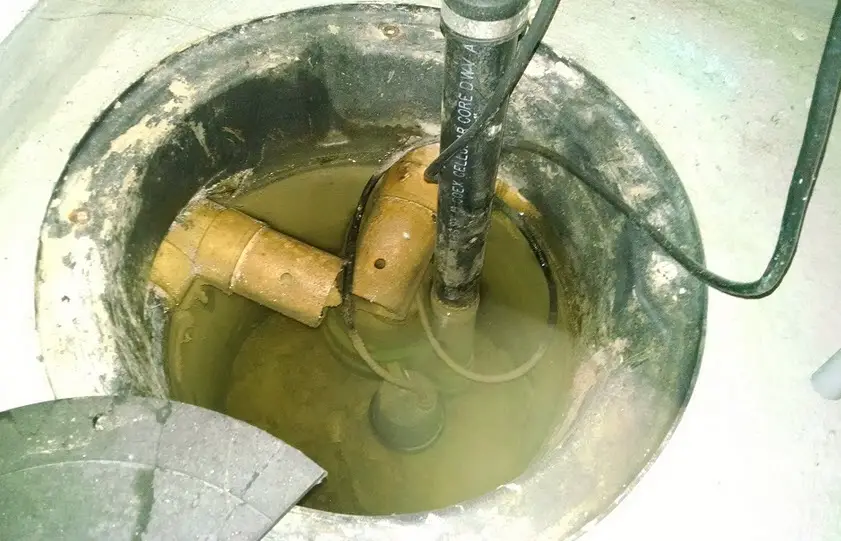 Let’s get into a detailed approach:
Let’s get into a detailed approach:
The sump pump has a limited capacity/size
Sometimes the sump pump cannot manage the water coming in because of the weather or your geographical location. As a result, it will try to remove excess water from the basement. The solution is to get a stronger sump pump than the current or a larger one.
Avoid the plastic models when you look for a sump pump, as they will burn out in time. Make sure that you examine the type of sump pump before you set it up. The main kinds of sump pumps are:
Primary
It’s the maim pump that removes water from basements. It contains two kinds of sump pumps:
- The submersible pump is connected to a motor and entirely submerged in water.
- The pedestal pump is small and has a motor on top. It’s excellent for a small pit and moves small amounts of water.
Backup
In case the primary pump loses power or fails, the battery-powered backup will move the volume of water
Combination
This sump pump combines the primary and battery backup pump into just one unit.
If the sump pump fills with water, you will need to get a large pump, set up a backup pump, and even install a second pump in the basement.
The sump pump’s switch is stuck
Your sump pump might fill water without stopping because the switch is stuck. The float switch has to turn on/off the pump every time the water level rises/falls. It might stop the pump from properly draining or turning on if it gets stuck.
You can fix the issue by manually flipping the switch. If this doesn’t fix the problem, you might have to contact a professional to check out the sump pump and discover the problem.
The sump pump doesn’t have a check valve
If the check valve is missing or failing, the sump pump could keep filling water. Sump pumps are set in below ground level and the water has to be pushed at an upward level. The check valve has to stop the water from coming back down into the pit; if the valve is missing or failing, the sump pump could keep filling with water.
You will have to replace the check valve if it’s missing or failing. Even if replacing the valve isn’t the most complex process, we recommend you call the professionals to ensure that the new valve works properly.
The sump pump fights high groundwater levels
High groundwater levels can also make your sump pump fill with water without stopping. Melting snow, heavy rains, or underground springs are causes of this. Such conditions might continuously bring water to the sump pump, keeping water inside the pit and overworking the system.
When the water table around the sump pump is too high or is replaced all the time, you should upgrade the pump or set up the second pump in a lower level or another area of the basement.
The sump pump has a clogged valve or drain
Water will keep getting inside the pit if a valve or drainage is clogged. If the sump pump doesn’t have a lid on the top, the risk of getting filled with dirt and particulate matter is high. As a result, the drainage will no longer be adequate.
Additionally, the sump pump pieces might get dirty and work slower in time. Therefore, the sump pump will have difficulty removing water from an area. If the sump pump runs slowly or the drainage is failing, you might have to examine the system to drain water or replace the sump pump. We recommend you have a designated drainage system for your sump pump.
11. The sump pump keeps cycling
Fast cycling is a symptom of a fault in the pump’s float switch most of the time. Replacing the float switch is the most straightforward solution to the short-cycling issue. We have to take a closer look to help you completely understand the problem and the fixing.
When the water drops, the float switch gets low again and turns the switch off. If the sump pump keeps cycling, the float switch is stuck on the “on” position in the sump pit. Sometimes, debris in the sump liner can jam the float switch in an “on” position.
It’s not enough to understand the issue, though. You also need to learn how to fix it. Here’s what you can do if the sump pump keeps cycling even though there’s no water:
- Unplug the pump from the outlet
- Clear the sump pit
- See that the float moves up and down without any restriction
- Place the sump pump in the pit’s center
- Plug the sump pump back in and see if it still keeps cycling
We want to remind you that a sump pump runs per cycle for around 10-15 seconds. If the sump pump runs every minute, but you have high levels of moisture/rainfall, the problem may disappear on its own. A record rainfall might make your sump pump run without stopping.
12. The sump pump is loud
One thing you need to learn as a homeowner is that you cannot ignore the sump pump noise. A sump pump making noise is never good news and you shouldn’t postpone addressing the issue. If the sump pump stops working suddenly, the house will flood the next time a storm hits your area.
Making a difference between regular noise and unusual noise can be an issue for many homeowners, so here is some basic information:
Normal noise
Regardless of what you might think, a loud hammering noise is normal for a sump pump. The sound doesn’t inform you that there’s something wrong with the sump pump. It doesn’t mean that it’s a pleasant sound, nevertheless. You should set up a quiet check valve (a spring-loaded model) to reduce the noise.
Noises that should worry you
There are plenty of noises that signal abnormal operation of your sump pump. Details on the most common unusual sounds come next:
Slurping
If the pre-set shutoff height of the pump isn’t correctly set, the sump pump will make a slurping noise. The pump is supposed to turn off before the point where water gets to the pump’s intake area. You want to call a professional to examine the pump and adjust the shutoff height for proper operation.
The pump runs without stopping
When the sump pump doesn’t stop running, the pump may not be large/strong enough for your basement. With sump pumps, you don’t want it to be too small or too big for your house. The perfect sump pump matches the size of the basin where you set it up. Therefore, if the pump is oversized and set up in a small basin, it will pump more water than the basin can take in. Not only that a pump that runs continuously is loud, but it can also run dry and break down.
Vibration
When the discharge pipe connects to the sewage pipe, you will probably observe a vibrating noise because the pump takes the water throughout the plumbing system. Wrapping the lines with some foam rubber insulation will dampen the vibration and the noise.
There are laws requiring that the discharge pipes divert water right to the outdoors and not through the sewer pipes in some areas. We suggest you hire a contractor to re-route the discharge pipe. This way, you will also get rid of the vibrating noise.
13. Sump pump loud bang? Here’s what do to about it!
When you hear a loud bang coming from your sump pump, it’s probably because the pipes aren’t correctly covered or insulated. When they hit the surrounding walls, the pump basin, or the lines, they will make banging noises.
 Additionally, they vibrate when water goes through the pipes and make a loud banging sound. The sump pump lids don’t feature rubber stoppers under them to block the noise. Insulating or covering the lines and surrounding walls with thick insulation can reduce the loud banging noise. Sometimes, the loud banging noise appears when the pressure in the pump changes and air bubbles become trapped.
Additionally, they vibrate when water goes through the pipes and make a loud banging sound. The sump pump lids don’t feature rubber stoppers under them to block the noise. Insulating or covering the lines and surrounding walls with thick insulation can reduce the loud banging noise. Sometimes, the loud banging noise appears when the pressure in the pump changes and air bubbles become trapped.
At the end of its lifespan, an old sump pump will also make loud noises and need to be replaced.
14. Sump pump making noise after rain
After heavy rainfall, unless you have an adequate sump pump, hydrostatic pressure will push water through the walls and floors of your home. It’s only a matter of minutes until you deal with flooding.
Water will flow and collect into the pit with a sump pump and a sump pit; water will flow and gather into the pit. The pump will activate and start removing the water.
What are unusual running conditions?
It’s perfectly normal for the sump pump to operate until it removes water, but in some cases, it will start making noises or running continuously. When the float switches become jammed at a high level, the pump will continue to operate even if the water level in the pit drops. A malfunctioning check valve is another possibility of abnormal activity. If it works fine, the check valve should stop the water from falling back into the discharge line and into the pit. Should it not work correctly, it could allow water back in and make the pump run continuously.
Can you prevent the loud noises?
One thing to remember about sump pumps is that they have to match the house’s capacity to prevent flooding. If the pump is too small, it will run continuously, but it won’t be able to remove the water. Also, keep in mind that the sump pumps are mechanical devices and require regular testing and servicing.
15. Sump pump not draining. Here’s why!
Even if the sump pump does the heavy work to remove water coming into the pit, it depends significantly on the other components. Should the drainpipe (the discharge pipe) becomes clogged, the pump won’t be able to move water from the basement and away from your home. If water moves slowly or not, debris might block the drain pipe. Cleaning the line is a sure fix and you don’t even need to call the plumber to do it.
Here is what you will need to clean the blocked drain pipes:
- Wet-dry vacuum
- Plumber’s snake
- Garden hose
- Screwdriver
Follow these steps to clean the pipe:
Step 1
If the pipe has a screen at its end, you need to remove it and rinse off debris built up on the screen. The end of the drainpipe is typically outside the house and the line drains on a downslope away from the home.
Step 2
Look for any blockages in the pipe and remove them, if necessary. Put the screen back in its place and get back inside the house. You need to turn the power off at the breaker or unplug the sump pump.
Step 3
Use a wet-dry vacuum to remove the water in the sump pit. Use a small container ( a can will do) to scoop the water and a bucket.
Step 4
You need to take the sump pump out of the pit, so grab it by the body or the handle. Avoid lifting the pump by the power cord or the float switch.
Step 5
Continue with loosening the clamp holding the drain pipe in place and remove the drain pipe from the pump’s main body.
Step 6
Use a plumber’s snake and insert it into the pipe’s end. Push the snake through toward the other end.
Step 7
Hold the pipe over a sink/bucket and spray water down the line with a garden hose. Make sure that the hose has a high-pressure nozzle. If the plumber’s snake doesn’t remove the blockage, you should do this step.
Step 8
Insert the plumber’s snake once again to remove any remaining debris, particulate matter, etc., inside the pipe.
Step 9
Rinse the pipe for one last time to remove all debris from the line.
Step 10
Put the drain pipe back, attach it to the pump, and secure it by tightening the clamp.
Step 11
Place the pump back into the pit and turn on the power. Turn the pump on and see if it all works by pouring some water into the pit.
16. Sump pump not turning on?
Ideally, you should have a cast-iron sump pump, a secondary sump pump, and a battery backup system. There are four leading causes of a sump pump not turning on, so keep reading to find out more:
The system is clogged
If the drain system is appropriately installed, it will collect the water from the basement and take it right to the sump pump. If the drain is clogged with debris, mud, or iron ochre, the sump pump will not have any water to take away from your house.
The risk of drain clogs is high if there is a large open gap along the floor. Even if the gap is made to collect water from the walls, it will also make debris deposit on the basement floor. The sump pump can also become clogged as large debris particles have entered the pump. Even if your sump pump has a filter screen, debris can clog the filter and stop the pump from turning on.
The sump pump has burned out
The mechanical failure of a sump pump happens due to overheating. When the sump pump is operating, the motor generates a lot of heat. If your system can quickly spread the heat away, it will last long. The perfect sump pump can be submerged in the water, which cools it down.
We remind you that it’s crucial to have the right size for the sump pit. If the sump pit is too large and too deep, the sump pump will pump away water without being necessary. If the sump pit is too small, it will make the sump pump run more frequently, which can lead to overheating and, eventually, burning of the pump.
The pump’s float switch has failed
The sump pump turns on and off according to its “float switch” position. When the water rises in the sump pit, the switch increases and falls; as it rises to a particular level, the pump starts pumping out the water. As the float switch decreases with the water level, the system turns off again.
It’s pretty standard for a sump pump to produce vibrations when operating and they can “wander” around the sump pit. If the wandering makes the float switch be pressed against the side of the sump pit while in the “off” position, the system won’t turn on anymore.
Similarly, some float switches are hollow and filled with water. If so, the water-filled float switch won’t rise as it should, and the system won’t turn on anymore.
The sump pump has a power problem
There are many reasons why sump pumps lose power, but some are more common than others:
- There’s a blown a fuse on the circuit where the sump pump is plugged
- The sump pump is unplugged because you had to use its outlet. You simply forgot to plug it back in.
- There was a power outage during a rainstorm
- The battery backup has run out of power
17. Sump pump not pumping—is it a severe problem?
A sump pump not pumping water out is something you have to solve the moment happens. There are many possible causes for this to happen and we recommend you check them all and not wait to fix the problem:
The drain lines are clogged
If the drain lines are clogged, the risk for your sump pump not to pump is high. If water cannot get out of the end of the lines, water will fill up the lines, basin, and body. You need to clean the lines as often as necessary. Regular maintenance for both the drain lines and the sump pump will reduce the risk of clogging.
The motor is burned out
Motors will burn out because of overheating. To avoid overheating, you have to estimate how much water will get to the pit. If the sump pump is small and there is too much water, the pump will burn out, and the basement will flood. At the same time, if the motor is too strong and doesn’t have any water to drain, you will have to deal with various issues.
The impeller is broken
The impeller pushes water from the interior of the pump into the drain lines. However, the impeller is fragile, and debris and small pebbles can easily damage it. When the impeller no longer spins or has been chipped or cracked, you might need to get a new pump. We recommend using a screen to stop particles from getting inside the pump and damaging the impeller.
Examine the impeller by checking out the pump’s body when operating. If everything’s okay, you should be able to feel the inside spinning.
The check valve is broken
The check valve has to stop the water from falling back into the pool. If the check valve is faulty or stuck, it will no longer be able to stop the water from getting into the drain pipe.
There are some mechanical or electrical problems
All things considered, sump pumps are still devices, so they do present a risk for electrical and mechanical problems. You can reduce the risk of such issues by buying a high-quality sump pump according to the size of the basin and performing maintenance of the system.
18. Sump pump not turning off?
If the sump pump doesn’t turn off, it will eat up a lot of energy and last for less than it should. Additionally, a sump pump not shutting off will overheat and need regular repairs. None of these effects are minor and you should address the problem of your sump pump not turning off.
The most common reasons why a sump pump doesn’t turn off are:
- Faulty impeller
- Leaking discharge line
- Clogged intake screen
- Undersized sump pump
If the sump pump runs without stopping when there’s no water present, a stuck float switch causes the problem. Let’s take a closer look at the causes:
Undersized sump pump
When the sump pump is too small, the system will struggle to pump the water out of the pit as water comes in continuously. As a result, the sump pump will operate for a longer time. Sump pumps are sized to the number of gallons of water per hour (GPH) they can pump out of the sump pit. The higher the GPH is, the faster the sump pump will pump out water.
You need to see if the pump is too small for your household.
There are two ways to do it:
Find out the sump pump capacity needs
On a rainy day, run the sump pump until the water goes under the shutoff level. Wait for a minute before you measure how high the water has risen. Every inch of water inside the pit is equivalent to 1 gallon (give or take). Multiply the number of inches the water has been increased in a minute by 60—you will get the volume of water inside the pit during one hour of constant rain.
We advise you to multiply the number you get by 1.5 to stay on the safe side. You will obtain the pumping capacity you need. If the final GPH you get is higher than the GPH of the current sump pump, you will need to get a new pump with a higher pumping capacity.
Check out the sump pump’s performance
If you simply see if the water inside the pit isn’t rising/falling as it should, you should call a professional. He will decide if the sump pump has adequate capacity for your household or not.
Clogged inlet screen
When the sump pump starts running, it will pull water into the pump with a motor. It depends on the model, but typically, the water has to go through an “inlet screen” to stop particles from jamming the motor. In time, debris and dirt will clog the screen, so the sump pump won’t be able to pump out as much water. Therefore, the sump pump won’t turn off and try to remove water.
Here’s what you should do:
- Turn off the power to the sump pump and take it out of the sump pit
- Check out the screen to see if there’s debris
- Use a toothbrush to remove waste and dirt. You can also clean the screen with a hose.
- Put the sump pump back into the outlet and place it into the pit. Should the pump run continuously without removing water from the pit, you need to call a professional for further investigation.
Faulty check valve
The check valve is essential to prevent water from falling into the sump pit. If the valve is faulty or clogged, water will go back into the pit, making the sump pump work continuously without any results. If you know your way around sump pumps, you should try to remove the check valve. Examine the vale and eliminate debris that might block the valve.
Put the valve back in its place and see if it starts working. If the problem persists, you will have to contact professionals for servicing.
A leaking discharge line
The sump pump’s discharge line has to take water outside and away from the house. Most discharge pipes are made of PVC piping and they will wear out in time; leaks will also develop. If not managed, the leaks will only get bigger, and water won’t be able to get outside but drip along the line and back to the sump pit. As a result, the sump pump will continue running as it struggles to empty the pit, just as it’s supposed to.
If you suspect that this is the issue with the sump pump, go and examine the discharge line. Should you notice water dripping down along the line or cracks, you must contact a professional to replace the discharge line.
A faulty impeller
The impeller is a motorized device that sucks water into the pump while spinning. Its spinning motion contributes to pushing the water through the discharge pipe. Should the impeller be clogged or close to its lifespan, the sump pump will keep on running without actually pulling and removing water.
You should call a professional; he will decide if the impeller needs repairs or replacement.
19. The float switch is stuck in the ON position
When the sump pump doesn’t stop running and there’s no water, the float switch may be jammed in the on position. When everything is fine with the sump pump, it will turn on and off with the help of the “float switch.” It’s practically a buoyant ball that floats up when the water level in the pit increases. The float switch connects to a lever that turns the pump on and off.
Therefore, the sump pump will turn on when the float switch rises. As it’s doing its job to remove water, the water level should drop, along with the float switch that will make the sump pump turn off. However, if the float switch is stuck in the on position, the sump pump will go non-stop, even if the pit is empty.
Even if we’ve covered this scenario already, here’s what you should do if the float switch is stuck in the on position:
Unplug the sump pump
Most homeowners plug the sump pumps in nearby outlets. Unplug the pump so that it stops running. You will be able to check out the float assembly.
Clear the sump pit
Rocks, dirt, and debris can stop the switch from lowering. Seek to remove them to help unblock the switch.
Make sure that that float moves freely
Manually lift and lower the float. Some floats move vertically up and down a rod, whereas others float freely up and down. Regardless of your model, make sure that nothing stops the float from moving freely.
Place the sump pump in the center of the pit
Due to the constant motor’s vibration when operating, the sump pump can move and pin the float switch against the liner. Place the pump back in the center of the pit to avoid such an effect.
Plug the pump back in
Plug the sump pump back in and see if it is still operating without stopping. If the problem persists, you need to contact a professional to examine your system.
20. Sump pump overflows
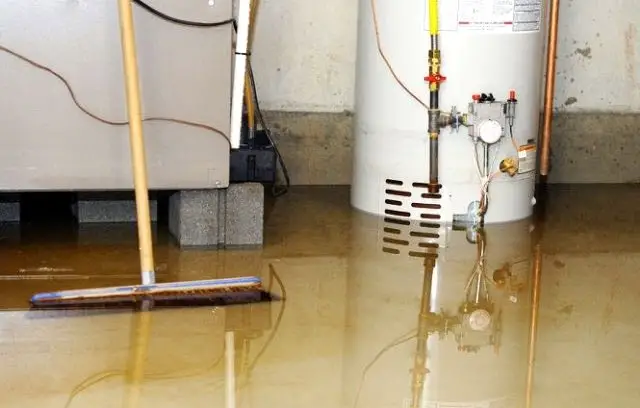 A sump pump overflow typically happens due to torrential rain and power outages. However, that’s not the only scenario causing the overflow. If a sump pump stops operating and causes overflow, the following steps will help you solve the problem:
A sump pump overflow typically happens due to torrential rain and power outages. However, that’s not the only scenario causing the overflow. If a sump pump stops operating and causes overflow, the following steps will help you solve the problem:
See if the sump pump has power
A battery backup is crucial for the sump pump’s operation in a power outage. If you have power in the house but the pump doesn’t run, see if there’s a tripped circuit or a blown fuse. We recommend buying a high-quality battery backup system to ensure the pump still runs during a power outage.
Re-set the unit
Unplug the sump pump and let it rest for several minutes. Afterward, plug it back in and activate the pump. Even if the pump starts operating, you still want to set a reminder and have it checked by a professional as soon as you can.
Restart the motor
Assuming the basin has a cover, lift the lid and pull upwards on the float switch. If you don’t hear the motor running, a mechanical failure could cause the pump not to run and overflow.
Examine the float switch
Tiny cracks and punctures are enough for water to seep into the housing of the float switch. To examine the float and look for signs of wear. Inspect the bracket and see if it still moves freely. If not, the float switch could be the pump overflowing. Replacing the float switch may be the solution.
Take a look at the check valve
Also known as the sump pump overflow valve, the check valve prevents water from falling back into the basin. Take a good look at the valve and remove debris and dirt buildup. You might have to remove the pipe over the valve in severe clogs.
Clear out the weep hole
Many submersible sump pumps feature a small opening on the discharge pipe between the unit and the check valve. The weep hole helps air escape when the pump runs and reduces the risk of the equipment locking up. When the weep hole is clogged, you need to use a strong wire to clear it.
Clean the impeller and basin
Start by unplugging the pump before you get into the basin. Lift the unit so that you can examine the impeller. The impeller must be clean to spin and push water out of the basin and into the discharge pipe. Seek that the impeller isn’t clogged and remove debris in the basin.
Take a look at the discharge line
The sump pump discharge line can become clogged after months and years of use. Start by unplugging the unit, removing the pump from the basin, and disconnecting the discharge pipe. Use a plumber’s snake to unblock the line. Seek that the end outside the house has no more debris and leaves.
21. Sump pump is overheating
Most sump pumps will not burn out, but they can overheat. Even the low-end sump pump motors feature thermal protection built-in, whereas submersible models require water around the motor to cool it down. When the pump overheats, you should simply turn it off and allow it to cool down.
But is it okay for sump pumps to get hot? We want to remind you that sump pumps aren’t made to run continuously. For example, if the submersible pump motor runs “on” cycles and overheats for a long time, water in the sump can get boiling.
The sump pump turns on and off in intervals according to the current water levels with regular cycling. When it doesn’t stop running, the motor elements will get hot. Therefore, the water will go through the motor and get hot.
22. Sump pump odor—what’s normal and what’s not?
If the sump pump has a problem, it will probably cause a specific smell. The sump pump smell can stink up the basement and even travel inside the house.
What are the most common smells of sump pumps?
Here are the most common smells that can occur with a sump pump:
Mildew
Mildew is relatively common with a sump pump as it has water inside all the time. The risk of growing mold and mildew is high. Like with everything near water, you need to keep the sump pump dry to reduce the risk of mold and mildew.
Gas
The sump pump can generate a gas smell that resembles gasoline initially. However, the scent comes from the sewer. The sewer gas goes inside the house when the sump pump dries out. The waste generates a smell, which contains toxic and non-toxic gases. We recommend you manage the gas smell as it can cause health issues.
Waste
Even if it’s not the most fun topic to talk about, waste gets inside the sump pump most of the time. As a result, waste materials will build up in time. The buildups can turn into clogs. We recommend cleaning maintenance to eliminate the unpleasant smell.
Sulfur
The smell of rotten eggs (sulfur) comes from the sump pump. The most common cause, though, is dirt buildup.
What causes the sump pump smell?
Some of the most common causes of the sump pump smells are:
Stagnant water
Sump pumps have to collect water before drying out. The water stays in the basin without moving for quite some time. In a moist environment, the mildew and mold will rapidly grow. The musty smell will be unpleasant even if the mold and mildew growth doesn’t alter the sump pump’s activity.
Dry sump pump
Sump pumps to dry out after long periods of use. The sewer gas that deposits in the pump will travel inside the house as the water can no longer shield the air from the gases. Ideally, the foul smell is the only effect you need to deal with. Sometimes, though, the sewer gas leaks cause health issues for people inside the house and pose a fire risk.
Dirty sump pump
The sump pump might smell because it’s dirty. Since the sump pump manages waste, it’s understandable why it collects debris and dirt rapidly. Even if the problem isn’t severe at first, the over-time buildup can cause a blockage in the sump pump.
Cracked/broken parts
A bad sump pump smell can signal a broken/cracked part in the plumbing system. The issue could be with the plumbing system itself or right on the sump pump. Regardless of the cause, you need to fix it right away.
Waste buildup
The waste buildup will generate an unpleasant sump pump smell. Since you use the sump pump a lot, it will collect water. If you’ve been using the sump pump for many days and weeks, the waste will build up and cause a foul odor inside the house.
How to remove sump pump smell
Your sump pump needs professional maintenance once a year, but you can still try some things to eliminate the foul odor.
Clean the system
You will have to remove the pump from the sump pit and clean the pump with warm water. Put on protection gloves, goggles, etc. You can clean the sump pump every six months or once a year—it depends on how often the sump pump works throughout the year.
Use a diluted bleach solution
You can remove the mold and mildew growth with a diluted bleach solution. Pour some of the solutions into the sump basin. Even if the mildew isn’t causing the smell, the bleach solution will freshen up the system and eliminate foul odors.
Seal cracks and leaks
Sealing the cracks and leaks is one of the most effective methods to get rid of the foul odor of the sump pump. Examine all the water systems and pipes for cracks and leaks and use a waterproof sealer. Take a look at the sump pump and the concrete around the system.
Refill the water
Refilling the basin with water will make the bad smell disappear within minutes. Sometimes, the sewer gases in the sump pump system cause the odor, and a layer of water will reduce the smell. The water will filter the gas particles and decrease both the scent and the adverse effects of sewer gases.
Maintenance
Take time to keep the system in good condition and prevent bad smells. Clean the sump pump from time to time and have it checked out by a professional once a year.
Call a professional
If you have tried all the previous methods and the foul smell lingers, you should call a professional to examine the system.
23. The sump pump runs every 30 seconds – should you worry or not?
If the sump pump starts running every 30 seconds, one of the following scenarios can be the cause of it:
The sump pump is below the water table
One of the most common causes of this kind of problem is the location of the natural water table. The water table refers to the level where water stays in the ground around your house. It’s expected for the water table to increase when it’s raining naturally. Should the water table rise higher than your basement floor, the water will seep between the basement slab and the foundation wall.
Some houses have a built-in drain tile system in the foundations. It’s a perforated pipe system parallel to the “footer” at the foundation’s bottom. It relies on gravity to take groundwater into a pit placed on the basement floor, the sump. If the water level in the sump pit increases, the float switch will force the sump pump to operate. The pump will start removing the water from the pit through a pipe and away from your house.
If the sump pump is located below the water table, you may increase it so that water will have to get to a high level before it starts operating. Placing a round steppingstone at the bottom of the pit is one standard method. This way, the pump will sit a bit higher in the pit. It’s not an ideal solution, but it can give results.
The weather is cold
During winter, the sump pump drainage lines may freeze and block the pipes. Therefore, the sump pump will start more frequently as it tries to remove rising water from the sump pit before it meets the ice blockage in the drain pipe.
You can add heat sources, such as a hairdryer right at the drainage pipe. If the drain pile is frozen farther down the line, you will have to use other methods. Buy a thermostat-controlled heat cable and apply it to the outdoor section of the sump pump’s drainpipe. Plug the cable into an electrical outlet with GFCI protection. The heating cable will rapidly thaw the pipe and reduce the risk of future freezing. Seek to use an extension cord for outdoor use.
Remember to keep the connections elevated, so they don’t touch the groundwater. Use some waterproof electrical tape to wrap the plug connection; it will keep it dry when exposed to snow or rain. We want to warn you that heat cables cannot take on year-round use. If misused, they can cause a fire. Therefore, remember to remove the heating cable once the cold weather has passed.
The float switch is jammed
When the float switch is triggered, the sump pump will start operating. The risk for float switched to become jammed is never null. The sump pump will run more often (30 seconds, for instance) and even continuously. When the sump pump float switch remains stuck in the on position, the pump will continue running until you manually turn off the switch.
The most frequent cause of a jammed float switch is the tangling of the power cord. It’s pretty often that the cable stops the float switch from turning on, which makes the sump pump not work and your basement gets flooded. Trace the path of the power cord and see that it’s not floating around the sump pit.
You can use zip ties to secure the cord to the pump’s vertical drainpipe. This trick will stop the cord from getting into the float switch’s path. You don’t necessarily need to replace the float switch. If the float switch is at the end of its lifespan, the sump pump may also be at its end. Replacing only the switch won’t make sense in the long run.
Most plumbers won’t repair the float switch but prefer to replace the whole sump pump. If the sump pump operates often, you should replace it every five years. Otherwise, you will only need to get a new pump every eight to ten years.
There’s negative drainage
Negative drainage around the foundation causes all sorts of problems. Negative drainage means that the slope of the yard tilts toward the house. The yard’s grade is significant as you want to divert water away from home.
Sump pumps have to work hard to take water away from the foundation. If there’s negative drainage, the water will slide toward the foundation and pool, so the sump pump will struggle to do its job. As a result, the pump will run every 30 seconds and even continuously.
Fixing negative drainage is as complex and challenging as it sounds. The most straightforward method to manage the issue is adding topsoil to fill low areas around the foundation. You will have to slope the dirt, so the rainwater flows away from the foundation out into the yard.
The severity of the negative drainage profoundly impacts the solutions. As long as you have a shovel, time, and a wheelbarrow full of dirt, you should be able to fix it alone. When the negative drainage is terrible, you might need earthmoving equipment, a truckload of topsoil, and even a team of professionals to improve the yard’s grade.
We advise you to hire a landscaping contractor to manage the negative drainage. You may dry attaching downspout extensions to the roof gutter downspouts. They will take water away from the foundation in case of heavy rainfall.
Find a sump pump service near you
All sump pumps require maintenance work and services from time to time. Ask your neighbors, check out the reviews from previous customers, and gather as much information as possible when selecting the professionals to service your sump pump.
